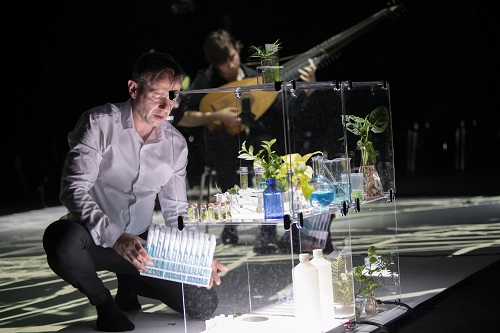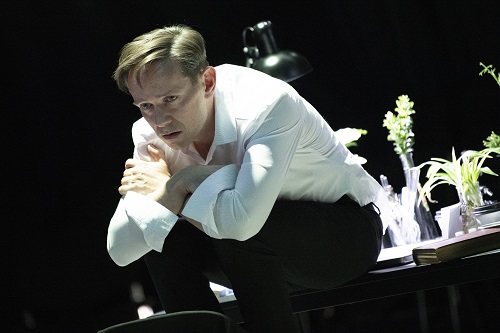‘Melancholy can be overcome only by melancholy.’ One imagines that countertenor Iestyn Davies and lutenist Thomas Dunford have taken heed of the words of the English clergyman Robert Burton – from his encyclopaedic tome The Anatomy of Melancholy, first published in 1621 and expanded from 1624 to 1651 – so oft have they been drawn to explore through music the malady which was both common and fashionable in Elizabethan England, associated with an abnormal mental state but also with intellect and refinement – at least in men. Think of Hamlet, described by Claudius thus, ‘There’s something in his soul,/ O’er which his melancholy sits on brood’.
Given the ‘motto’ that John Dowland took for himself, ‘Semper Dowland, semper dolens’ (Always Dowland, always doleful), and the astonishing oeuvre of lute songs and airs in which he explored – with paradoxical invention and fertility – pain, anxiety and inertia, it’s not surprising that Dowland, the man and the music, has come to epitomise that blending of the bleak and the beautiful that we associate with melancholy.
In 2014, Davies and Dunford released a disc of Dowland’s intimate songs and dances, The Art of Melancholy, on the Hyperion label. In November 2016, they presented a similar programme, The Anatomy of Melancholy, at Wigmore Hall in which a sequence of Dowland’s songs and instrumental pieces was interspersed with readings (delivered by Colin Hurley) from Burton and his contemporaries – Samuel Daniel, Ben Johnson, Sir William Leighton, Henry Peacham. Now the duo have returned to the theme once again, in an hour-long staged recital at The Pit Theatre in the Barbican Centre in which Dowland and Burton were woven with other, modern voices on melancholy and mourning – Sigmund Freud and the psychoanalyst Darian Leader – and with creative visuals by Netia Jones, presented on four wall-like screens hovering above the intimate stage.
In Mourning and Melancholia (1917), Freud describes the distinguishing mental features of melancholia as ‘a profoundly painful dejection, cessation of interest in the outside world, loss of the capacity to love, inhibition of all activity, and a lowering of the self-regarding feelings to a degree that finds utterance in self-reproaches and self-revilings, and culminates in a delusional expectation of punishment’. The same symptoms are evident in the mourner, but the latter is responding to a known ‘loss’ whereas the melancholic cannot consciously perceive what he has lost – or as Freud puts it, ‘he knows whom he has lost but not what he has lost in him’.
One might say that Iestyn Davies, a lonely figure on the small Pit stage – simultaneously fatigued and agitated, blanched by Stevie Porter’s lighting, isolated from Dunford who bent over his lute in trance-like creative exploration – was an embodiment of this unconscious loss and consequent ‘distressing self-denigration’. The audience seated on all four sides peered in at this ‘case study’ as he futilely sought to understand, and cure, his own condition. The books and laptop on the desk would provide no answers. In the corners of the room, glass cabinets displayed botanicals, bottles and vials, but they brought not knowledge, merely self-reproach. Moving restlessly from the medicinal plants and test-tubes to the modern-day sources of understanding, Davies was like a Dr Dee, fruitlessly seeking not alchemic transformation but chemical renewal.

For, as the readings from Darian Leader’s The New Black reminded the listener, nowadays melancholy has been medicalised. The Pharmaceutical Journal recently reported that antidepressant prescribing in England has increased by 35% in the last six years, from 61.9 million items in 2015/2016 to 83.4 million items in 2021/2022, and we were prompted to consider this dependency – and that today melancholy is often seen as synonymous with depression, and considered a physical not mental illness – by the disembodied voice which spoke over the janglings, by turns tetchy and dazzling, of Dunford’s lute.
It was not possible to discern when watching the live-streamed performance, but both performers were apparently lightly amplified. As one might expect, both the execution and expression of Dowland’s songs of sorrow were wonderful, the music almost ironically uplifting. During ‘Can she excuse my wrongs’, Davies pushed his fingers into a pair of medical gloves, the vigour of the melody conveying a driving determination for resolution and rest, even as the exuberant lute seemed to deny that hope and the voice-over informed us of Burton’s assertion that, ‘Most part of a lover’s life is full of agony, anxiety, fear and grief, complaints, sighs, suspicions, and cares’. ‘Come again, sweet love doth now invite’ was not so much bitter-sweet but edgily intense, pushing urgently forward though dissolving into a lovely ornament at the closing cadence in echo of the lute.

And, what of Netia Jones’s visuals? Perhaps they created more impact during the live performance in The Pit, but the imagery seemed indeterminate when viewed on a laptop screen. Perhaps that was the point: melancholy is unfathomable and unrepresentable; the melancholic is lost, disorientated. Bubbles rippled aimlessly across the screens, washed out shades of grey prevailed. Despite their utter isolation, even solipsism, in the theatre, lutenists and countertenor were brought together in an underwater communion on the raised screens – perhaps an allusion to Burton’s ‘vast, infinite ocean of incredible madness and folly’. Both Burton and Freud refer to Shakespeare’s characters as examples of specific psychological types, and it was hard not to think of Ophelia, that ‘document in madness’, whose female melancholy is viewed not as refinement but as frailty.
Despite the beauty of the musical performances, though, I found something ultimately dissatisfying about this ‘anatomy’ of melancholy. Perhaps it was that the central sentiment conveyed seemed so singular. After all, Freud acknowledged that the definition of melancholia ‘fluctuates even in descriptive psychiatry, takes on various clinical forms the grouping together of which into a single unity does not seem to be established with certainty’; and Burton explored a miscellany of mental afflictions seeking to explain and account for the complexities and conundrums of human emotion and thought, through reference to an eclectic assemblage of ideas drawing upon literature, philosophy and science.

‘If there be hell on earth it is to be found in a melancholy man’s heart,’ Burton tells us. But also, that ‘Beauty alone is a sovereign remedy against fear, grief, and all melancholy fits’. Davies and Dunford framed their programme with Dowland’s ‘In darkness let me dwell’ which, appropriately, emerged from and subsided into a total black-out. But, if there is existential despair in the blackness, there is a sort of purity, too, a freeing of the ego, a beauty. Dowland’s musical representation of desolation is infinitely creative and thus, oddly, life-affirming. As the poet Richard Barnfield commented in 1597, ‘Dowland to thee is dear, whose heavenly touch/Upon the lute doth ravish human sense’, and in his own dedication to Lachrimae, Dowland observed that tears are not always shed in sorrow, but sometimes ‘in joy and gladnesse’. And, at the very close of the recital, there was indeed a hint of such dualities, the disembodied voice conveying Freud’s assertion that ‘One day, in retrospect, the years of struggle will strike you as the most beautiful’.
Interestingly, Darian Leader has suggested that melancholia should be wrested from the medics and given to the artists, who, from mourning and loss make something anew: ‘Freud names not psychoanalysis but culture as the only possible panacea for the terrible demands that civilised life places on us. In other words, he is saying that it is the arts that can save us.’ I couldn’t help feeling that what was missing from this recital was the sense that Dowland’s songs both evoke melancholy and cure it.
Claire Seymour
An Anatomy of Melancholy: Iestyn Davies (countertenor), Thomas Dunford (lute), Netia Jones (director, designer, video designer)
Pit Theatre, Barbican Centre, London; Friday 28th October 2022 (live stream).
ABOVE: An Anatomy of Melancholy, Pit Theatre, Barbican (c) Tristram Kenton